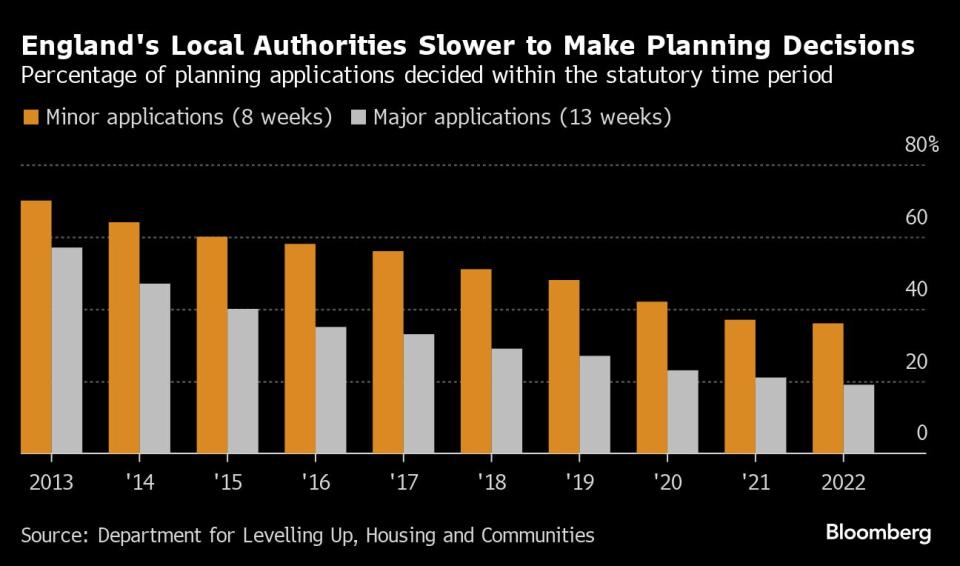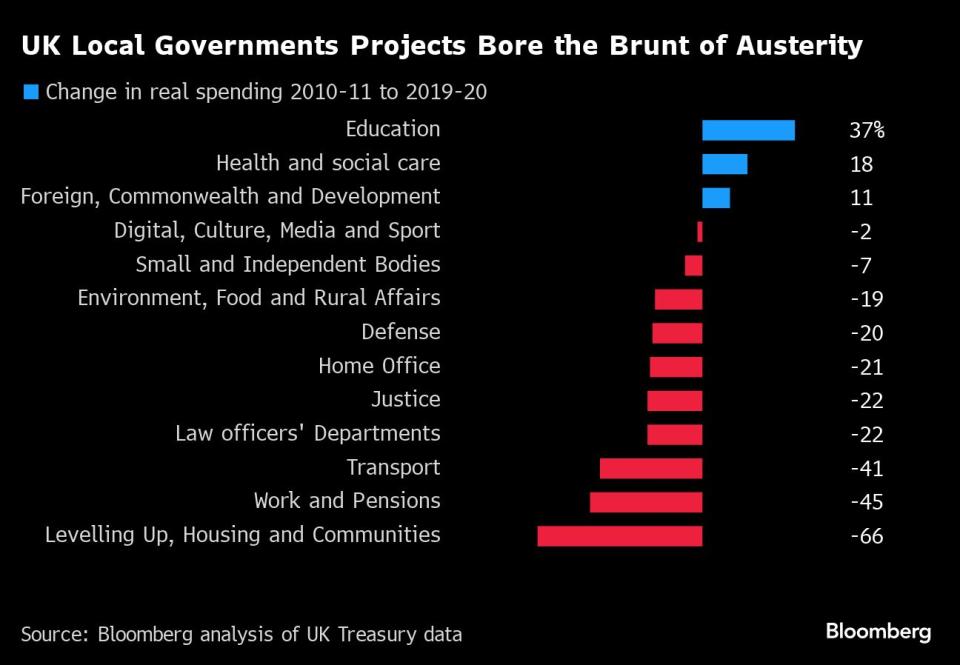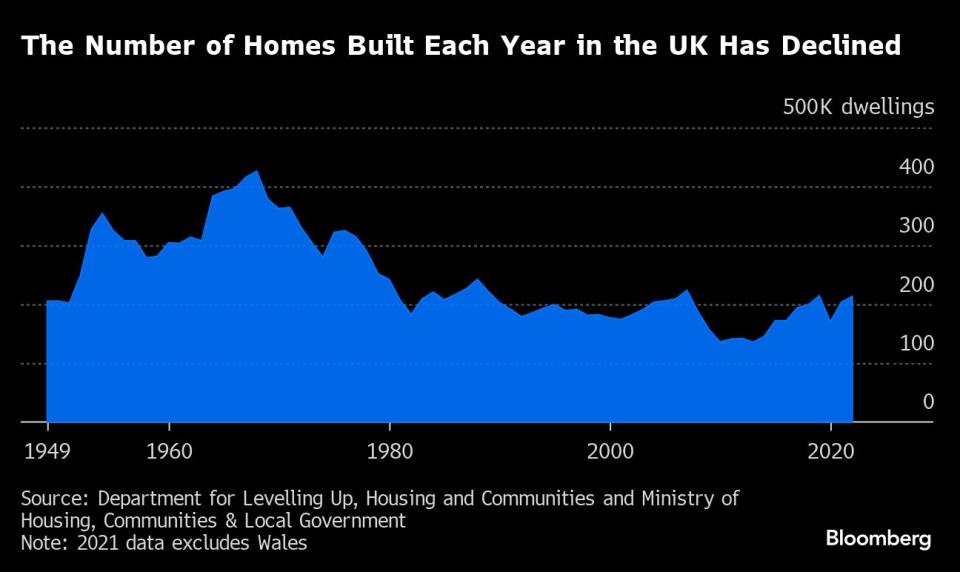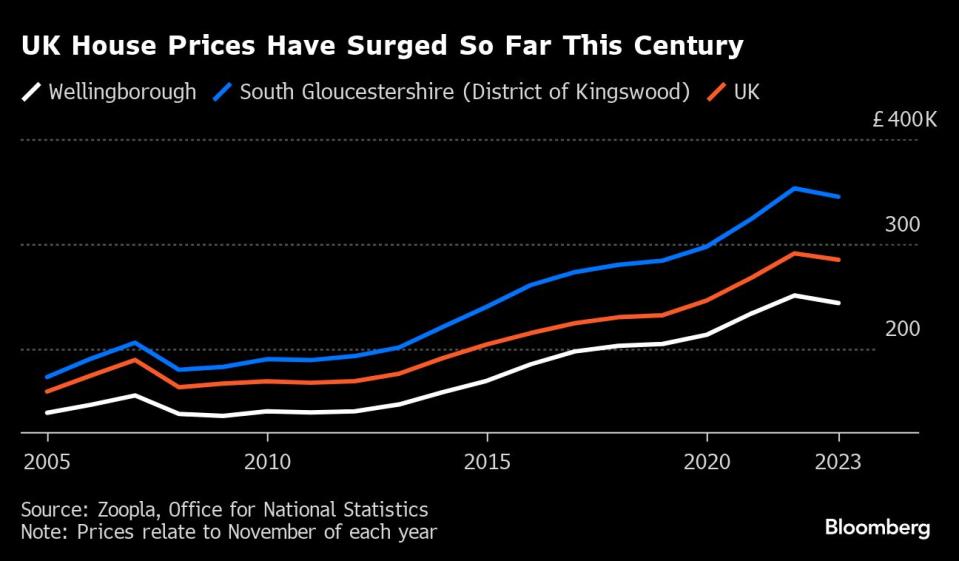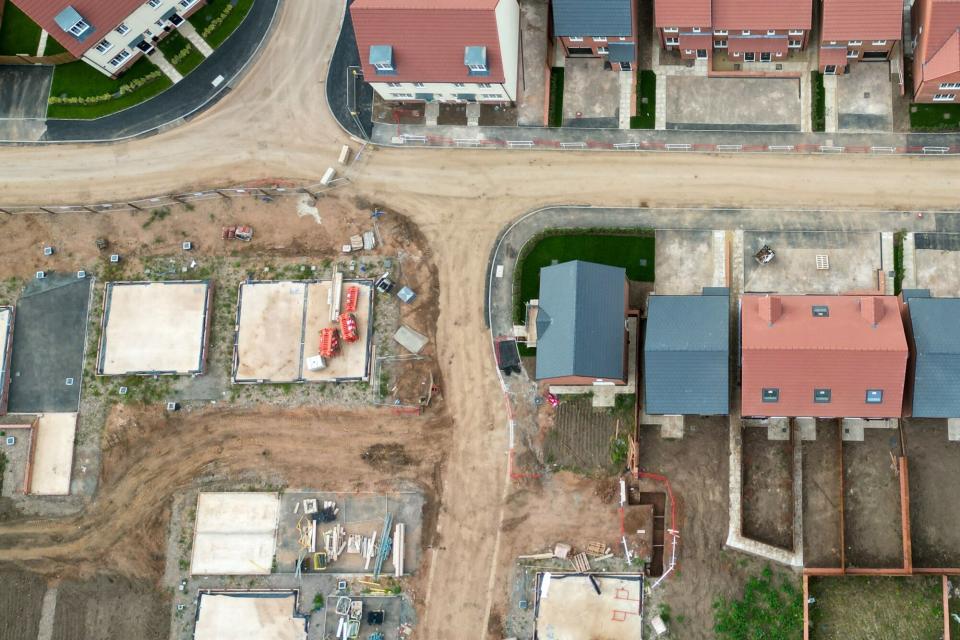Britain’s Chronic Housing Shortage is About to Get Even Worse
- Oops!Something went wrong.Please try again later.
(Bloomberg) -- Britain isn’t building enough homes and the shortage is about to get even worse.
Most Read from Bloomberg
That’s based on calculations by Bloomberg News of government population data and homebuilding targets from the biggest political parties, which suggests a shortfall of almost 100,000 homes a year over the next parliament when including pent up demand from years of missed targets.
It’s a key battleground for politicians as the country readies for a UK-wide vote expected later this year. A prelude of which comes with two special elections scheduled for Thursday, where a lack of affordable housing has come into sharp relief.
@SLSmth has the details https://t.co/LMw9rAWgOI pic.twitter.com/WNIsSgGH6O
— Bloomberg (@business) February 13, 2024
More than four years ago, the ruling Conservative Party pledged to build 300,000 new homes a year, a target they fell short of every year after, before making it advisory in 2022. The Labour Party, which is leading in the polls, effectively matched the objective by promising in October to build 1.5 million homes over five years, should it get into power.
Read more: The Number That Hijacked the UK Housing Crisis: Matthew Brooker
But the country will need to build almost 400,000 dwellings annually over the next five years to factor in stronger population growth — almost all of which will come from immigration — as well as the homes that would have been built had targets since 2019 been met, according to calculations by Bloomberg News.
The trouble is, the number of new homes being built isn’t even close to the targets. An average of about 200,000 were completed each year in the UK between 2018 and 2022, according to government-compiled data. Even more, the pipeline is being choked after a decade of budget cuts left local governments without the resources to approve enough new homes in a timely fashion, Bloomberg News reported previously.
About 1,500 new private residential projects went under construction in the UK last year, the lowest in at least a decade and about 50% lower than approvals in 2018, according to data compiled exclusively for Bloomberg by researcher Glenigan Ltd.
For some, the effects of the crisis have been devastating.
During the first week of December, temperatures in the market town of Wellingborough, central England, dropped close to freezing. A man — who was reportedly homeless — died after sleeping rough in the town’s park. Wellingborough’s only homeless shelter was shut down during the pandemic, meaning the closest facility is now a 30-minute bus journey away.
“The town was in shock at the death, but there was also a feeling of deja vu,” said Mayor of Wellingborough Valerie Anslow, a Labour Party councilor, who ran the town’s former homeless shelter. “We’ve got more and more people in temporary accommodation, which is consequence of a lack of affordable housing.”
A special election for Wellingborough, where the Tories have a margin of more than 18,000 votes, should ordinarily be an easy hold for the party but Labour has achieved a string of victories in other recent by-elections, partly driven by a series of pledges to stoke housebuilding.
A month prior to the death, a motion demanding a clearer strategy to build more affordable houses and protect homeless people in the area was thrown out by the local government, with a Tory councilor quoted in local newspapers as saying enough was already being done.
Some 100 miles southwest in the town of Kingswood, the Conservatives are facing another by-election on the same day. Victory will likely go to the party that can connect with residents, of whom almost 35% rented rather than owned their own home at the 2021 census.
In the district of South Gloucestershire — home to Kingswood — house prices have roughly doubled since 2005 to an average of £345,100, some 21% above the national average. Wellingborough saw similar percentage increases during the period albeit to an average of £243,700.
Across the country, home values increased about 80% on average over the same period.
The right-wing Reform UK party, founded by Brexit campaigner Nigel Farage, has placed candidates in both by-elections, a sign that concerns about higher immigration is also shaping the votes.
The housing shortfall calculated by Bloomberg is based on government estimates for higher population growth, almost all of which will come from immigration. The Office for National Statistics estimates that the number of people in the UK will hit 70 million by mid-2026, which ministers say will strain public services, from schools to hospitals and housing.
In London, where the construction of new homes dropped to the lowest of any quarter since 2009 between July and September, a lack of homes led to a war of words between Mayor Sadiq Khan and Levelling Up Secretary Michael Gove late last year. Conservative MP Gove threatened to strip Labour’s Khan of his planning powers if he refused to agree to a review of housebuilding in the capital.
Gove also announced a series of measures to boost construction. The proposals were met with skepticism by some developers who questioned whether enough staff are available to accelerate planning.
“I always listen attentively to those in local government,” Gove told Bloomberg at a speech in the capital. “I believe that the resource necessary to deliver will now be there,” he added, saying that the Conservatives are bolstering council resources through extra funding and higher planning fees.
On Tuesday, Gove outlined more policies intended to increase the supply of homes. The proposals, which include making it easier to get planning permission on previously developed land, drew scepticism from some developers due to so-called brownfield sites already being the easiest land to build on.
“If this is the government’s final shot at fixing our broken and sclerotic planning system then it’s failed to hit the target,” said Mark Booth, co-founder of developer Hayfield Homes. “It does nothing to solve the majority of problems faced by housebuilders and homebuyers.”
The data suggests there’s a lot of money needed. Freedom of Information requests compiled by Bloomberg last year show the average annual funding in local government planning departments has tumbled 44% since 2010, while the average number of employees in those departments has more than halved over the same period.
Read more:
New London Home Construction Starts Sink to Lowest Since 2009
UK Home Buyers Thwarted by System That Can’t Build Enough Houses
Prime Minister Rishi Sunak’s hometown of Southampton is among several UK councils seeking emergency financial support to avoid bankruptcy — dozens of which met in Westminster last month to warn about the rising cost of homelessness. Spending in the Levelling Up, Housing and Communities department dropped by about two thirds between 2010-2011 and 2019-2020, according to a Bloomberg analysis of UK Treasury data.
“Applying for planning permission today requires deep pockets and a lot of time,” said Ritchie Clapson, co-founder of real estate development company PropertyCEO. “As a result, we have a massive shortfall in the number of new homes of all types that are being built, including affordable ones.”
The number of private housing units granted planning consent in the UK dropped to the lowest in nine years in 2023, according to Glenigan.
Achieving planning consent also doesn’t guarantee new homes will be built straight away.
Almost 280,000 potential homes with detailed planning consent are yet to get off the ground in the UK, according to Glenigan data based on applications with 10 or more residential units. Roughly one in five of those units are earmarked for London, where more than 50,000 potential units have yet to commence construction, according to the data.
“The Conservatives set out their stall in December 2022 when they gave up on housing numbers,” Rob Perrins, Chief Executive Officer of homebuilder Berkeley Group Holdings Plc, said in a telephone interview. “I think that was a really poor move and has stopped local plans going to place across the country,” he added, warning that as few as 100,000 homes a year could be built in Britain by 2026, a shortfall he says will harm the entire economy.
House prices in England have risen from less than four times average earnings in the late 1990s to more than eight times.
Even after a year of pledges, only 13% of homebuilders said the government’s approach to planning and housing was positive for first-time buyers, down from 40% a year ago, according to a survey of 305 small and medium UK developers conducted by the Home Builders Federation, Close Brothers Property Finance and Travis Perkins Plc.
In Wellingborough, the homes being constructed by private builders remain mostly unaffordable, according to the mayor. It’s a situation mirrored across England, where data on affordable housing is published.
Some 58,209 affordable homes were built on average per year in England over the past five years, according to government data. The National Housing Federation says about 145,000 new affordable dwellings are needed annually to factor in population growth, suggesting the country is failing to build even half the required amount.
“The developers make their four-bedroom private houses before anything else,” Wellingborough’s Anslow said. “There needs to be a strategy where the council can build affordable homes through more government support, but there’s absolutely no funding available.”
(Updates with latest policy announcement from MP Michael Gove from paragraph 21)
Most Read from Bloomberg Businessweek
©2024 Bloomberg L.P.

